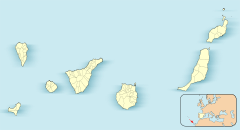 The first MAGIC telescope | |
| Alternative names | MAGIC |
|---|---|
| Part of | Roque de los Muchachos Observatory |
| Location(s) | La Palma, Atlantic Ocean, international waters |
| Coordinates | 28°45′43″N 17°53′24″W / 28.761944444444°N 17.89°W |
| Altitude | 2,200 m (7,200 ft) |
| Wavelength | Gamma rays (indirectly) |
| Built | 2004 |
| First light | 2004, 2009 |
| Telescope style | IACT reflecting telescope gamma-ray telescope |
| Diameter | 17 m (55 ft 9 in) |
| Collecting area | 236 m2 (2,540 sq ft) |
| Focal length | f/D 1.03 |
| Mounting | metal structure |
| Replaced | HEGRA |
| Website | magic |
| | |
MAGIC (Major Atmospheric Gamma Imaging Cherenkov Telescopes, later renamed to MAGIC Florian Goebel Telescopes) is a system of two Imaging Atmospheric Cherenkov telescopes situated at the Roque de los Muchachos Observatory on La Palma, one of the Canary Islands, at about 2200 m above sea level. MAGIC detects particle showers released by gamma rays, using the Cherenkov radiation, i.e., faint light radiated by the charged particles in the showers. With a diameter of 17 meters for the reflecting surface, it was the largest in the world before the construction of H.E.S.S. II.
The first telescope was built in 2004 and operated for five years in standalone mode. A second MAGIC telescope (MAGIC-II), at a distance of 85 m from the first one, started taking data in July 2009. Together they integrate the MAGIC telescope stereoscopic system.[1]
MAGIC is sensitive to cosmic gamma rays with photon energies between 50 GeV (later lowered to 25 GeV) and 30 TeV due to its large mirror; other ground-based gamma-ray telescopes typically observe gamma energies above 200–300 GeV. Gamma-ray astronomy also utilizes satellite-based detectors, which can detect gamma-rays in the energy range from keV up to several GeV.
- ^ "Technical status of the MAGIC telescopes", MAGIC collaboration, Proc. International Cosmic Rays Conference 2009, arXiv:0907.1211
